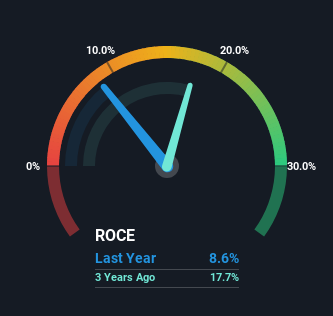If we want to find a stock that could multiply over the long term, what are the underlying trends we should look for? Typically, we'll want to notice a trend of growing return on capital employed (ROCE) and alongside that, an expanding base of capital employed. Put simply, these types of businesses are compounding machines, meaning they are continually reinvesting their earnings at ever-higher rates of return. However, after briefly looking over the numbers, we don't think Nihon Seiko (TSE:5729) has the makings of a multi-bagger going forward, but let's have a look at why that may be.
Return On Capital Employed (ROCE): What Is It?
For those that aren't sure what ROCE is, it measures the amount of pre-tax profits a company can generate from the capital employed in its business. To calculate this metric for Nihon Seiko, this is the formula:
Return on Capital Employed = Earnings Before Interest and Tax (EBIT) ÷ (Total Assets - Current Liabilities)
0.086 = JP¥1.0b ÷ (JP¥16b - JP¥4.6b) (Based on the trailing twelve months to June 2024).
Thus, Nihon Seiko has an ROCE of 8.6%. On its own that's a low return, but compared to the average of 6.4% generated by the Metals and Mining industry, it's much better.
See our latest analysis for Nihon Seiko

Historical performance is a great place to start when researching a stock so above you can see the gauge for Nihon Seiko's ROCE against it's prior returns. If you're interested in investigating Nihon Seiko's past further, check out this free graph covering Nihon Seiko's past earnings, revenue and cash flow.
So How Is Nihon Seiko's ROCE Trending?
In terms of Nihon Seiko's historical ROCE movements, the trend isn't fantastic. To be more specific, ROCE has fallen from 13% over the last five years. However it looks like Nihon Seiko might be reinvesting for long term growth because while capital employed has increased, the company's sales haven't changed much in the last 12 months. It's worth keeping an eye on the company's earnings from here on to see if these investments do end up contributing to the bottom line.
The Bottom Line
In summary, Nihon Seiko is reinvesting funds back into the business for growth but unfortunately it looks like sales haven't increased much just yet. Since the stock has gained an impressive 83% over the last five years, investors must think there's better things to come. However, unless these underlying trends turn more positive, we wouldn't get our hopes up too high.
If you'd like to know about the risks facing Nihon Seiko, we've discovered 2 warning signs that you should be aware of.
While Nihon Seiko may not currently earn the highest returns, we've compiled a list of companies that currently earn more than 25% return on equity. Check out this free list here.
Valuation is complex, but we're here to simplify it.
Discover if Nihon Seiko might be undervalued or overvalued with our detailed analysis, featuring fair value estimates, potential risks, dividends, insider trades, and its financial condition.
Access Free AnalysisHave feedback on this article? Concerned about the content? Get in touch with us directly. Alternatively, email editorial-team (at) simplywallst.com.
This article by Simply Wall St is general in nature. We provide commentary based on historical data and analyst forecasts only using an unbiased methodology and our articles are not intended to be financial advice. It does not constitute a recommendation to buy or sell any stock, and does not take account of your objectives, or your financial situation. We aim to bring you long-term focused analysis driven by fundamental data. Note that our analysis may not factor in the latest price-sensitive company announcements or qualitative material. Simply Wall St has no position in any stocks mentioned.
About TSE:5729
Nihon Seiko
Manufactures and sells antimony products and metal powders in Japan.
Outstanding track record with adequate balance sheet.
Market Insights
Community Narratives



